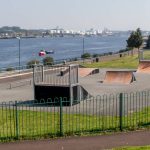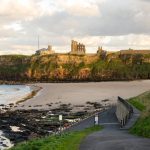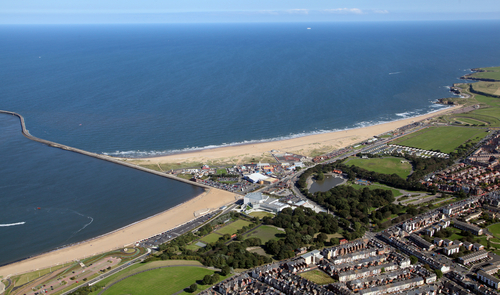
South Shields is a coastal town in the North East of England at the mouth of the River Tyne, about 4 miles downstream from Newcastle upon Tyne. Historically in County Durham, it’s now part of the metropolitan borough of South Tyneside. The town derives its name from the Anglo-Saxon word ‘schele’, meaning a temporary shelter, such as a hut or shed. Like the rest of Tyneside, the inhabitants of South Shields are commonly referred to as ‘Geordies’, and the local dialect as ‘Geordie’.
At the 2011 UK Census, the town had a population of 75,337, the third-largest in Tyneside area, after Newcastle and Gateshead.
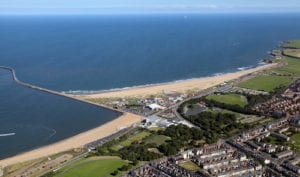
Image: Neil Mitchell/ Shutterstock.com
South Shields – A Fleeting History
The earliest evidence of a settlement around the area of South Shields dates back to pre-historic times. Signs of both Stone Age and Iron Age activity have been discovered at the site of the Roman Fort of Arbeia. The Roman garrison, whose name of Arbeia means “place of the Arabs” in Latin, was built around AD 160, and in AD 208 was expanded to help support the supply lines to the soldiers stationed on Hadrian’s Wall.
The fort was abandoned as the Roman Empire declined during the 4th century AD. However, the fort’s ruins can still be seen today, with some structures having been rebuilt as part of a modern museum and popular tourist attraction.
Archaeological evidence suggests that the site of Arbeia was utilised in the early post-Roman period by native settlers. The fort most probably became a royal residence of King Osric of Deira. This is based on the fact that Osric’s son Oswin, was recorded as being born at ‘Caer Urfa’, the name given to the fort after the Romans left. The Venerable Bede’s chronicles of around AD 647, recorded that Oswin had given a parcel of land to St Hilda for the foundation of a local monastery.
The Vikings Arrive
In the 9th century, the Vikings made raids on local monasteries and settlements all along England’s East coast, eventually conquering the Anglian Kingdoms of Northumbria, Mercia and East Anglia. A number of Viking ships have been uncovered just offshore of South Shields and nearby Jarrow, giving evidence of the extent of their activity in the locality. The current township of South Shields was founded around 1245 and was initially developed as a fishing port by the Prior of Durham Cathedral and Monastery.
The name South Shields originates from the Anglo-Saxon word of ‘schele’, meaning a temporary dwelling such as a hut or shed.
It was as early as the 13th century that salt-panning took off in the area as a small-scale commercial activity. However, trading of the small port was somewhat muted by the Burgesses of Newcastle. The Burgesses, a clique of medieval businessmen, locally known as the Hostmen, believed themselves to be entitled to the custom rights for any trade activity on the whole of the River Tyne. In 1259, Newcastle made a demand to the Prior of Durham for South Shields to cease all importing and exporting.
However, commercial activity at the port carried despite the threats of the Hostmen. In 1290, the Hostmen successfully petitioned King Edward I, managing to get an official embargo placed on both South Shields and North Shields, forbidding the loading and unloading of freight. However, the two Shields’ chose to willfully ignore the royal prohibition and once again carried on trading regardless of attempted outside interference. The early 15th century saw the town first referred to as ‘South Shields’ to distinguish it from the other ‘Shields’ on the north bank of the river.
The Civil War
In 1642, at the outbreak of the English civil war, the North East supported the King, while Presbyterian Scotland supported Parliament. In 1644, Parliament’s Scottish allies overcome the King’s loyalist forces, seizing the town and its royal fortification. The capture of South Shields gave the Scots a local base from which they could attack the heavily fortified Newcastle and a location from which they could take control of the strategic River Tyne.
In the 1760s, South Shields was still little more than a long narrow street running alongside the Tyne adjoined by some lanes and side roads. It was bordered by hills of ballast created by wastage from the offloading of visiting ships. In 1768, the Dean of Durham obtained parliamentary consent to undertake the development of 8 acres of church land. The land was used to house the market place along with several new streets of housing laid out in a gridiron pattern.
In terms of business, shipbuilding, salt-panning, coal mining and glass manufacture were all to become major industries within South Shields. Local salt-panning gradually began to expand in operation, such that by 1768, South Shields had more than 200 salt pans, making it the largest producer of salt in the country. Glass production which had begun in the town in the 1730s, and eight major glassmakers were established by the 1830s. By the 1850s, shipbuilding had also become a well-established industry in the town.
South Shields The Navy Town
It was notable towards the end of the 18th century, particularly during the time of the French Wars, that South Shields with its rich supply of experienced seamen, became a favoured hunting ground of the notorious press gangs, the thug recruiters for the Royal Navy.
The town would regularly fall prey to raids by these gangs, who were greatly feared, as men were often unwillingly pressed into naval service on poor pay and conditions.
Pressed recruits literally disappeared overnight, leaving their wives and family, more often than not, to rely on handouts from the local parish for survival. By the 1850s, shipbuilding had also become a well-established industry in the town.
In the 1800s, the town’s booming coal mining industry led to a massive increase in the town’s populace. The population rose from 12,000 in 1801 to more than 75,000 by the end of the 1860s. The incomers were largely economic migrants from Ireland, Scotland and other parts of England. In 1832, under the Great Reform Act, South Shields was granted borough status, and accordingly, allocated its own Member of Parliament. However, the rapid growth in population brought on by the expansion of industry made sanitation with the town a particular problem.
Clean water
Cholera outbreaks in the town were common, which was the motivation for the building of the Cleadon Water Tower to help combat the problem. In the 1850s, the Tyne Improvement Commission took over jurisdiction for the River Tyne, dredging it to make it deeper and building the large, impressive North and South Piers. to help prevent silt build-up within the channel.
The original town hall was built at the centre of the market place soon after it was established. In the 1850s, the town hall was subsequently purchased by South Shields Corporation from the church. In 1864, the construction of Customs House was completed.
In 1889, South Shields merged with several neighbouring settlements and was elevated to county borough status. By 1900, the town was a major industrial centre and continued to experience corresponding population and housing growth, the latter being mainly large areas of terrace rows to accommodate the working class. In the early 1900s, a new town hall was built at the heart of the town’s commercial centre in King Street.
South Shields At War
On 15 June 1915, during World War I, a German Zeppelin airship dropped 4 bombs on South Shields while on its return to Germany, after a raid on the Jarrow Shipyard. While 18 people were killed and another 72 injured during the raid in Jarrow, damage to South Shields was mostly superficial.
Sitting at the mouth of the Tyne, with a thriving shipbuilding and ship repair industry, South Shields along with much of the North East, was a regular target of the Luftwaffe during WW2. The town experienced more than 200 air raid alerts during the 1939 – 1945 War. The worst bombing incident occurred on October 2 1941, when 44 bombs exploded in the borough, causing 67 deaths, and 204 injures.
South Shields – The Modern Era
From the mid-20th century onwards, traditional major employers in the town such as the coal mining and shipbuilding industries were in decline due to a combination of political dogma and increasing international competition. In 1984, the town’s last shipbuilder, John Readhead & Sons, finally closed its gates, although it hadn’t actually built a ship for some 16 years.
Likewise, in 1993, the last working pit in South Shields, Westoe Colliery, followed the same fate. Despite a skilled local workforce, for many years South Shields along with the rest of South Tyneside, had the highest unemployment rate in mainland Britain. However, between 2003 and 2008, unemployment in the town and South Tyneside fell by almost 18%.
Today, the town relies heavily on the various service industries as a principal employer. Many of the town’s residents also commute to nearby Newcastle, Gateshead or Sunderland for work. South Shield’s 21st-century local employers are primarily involved in port-related activity, ship repair and the offshore sector, as well as those concerned with the manufacture, retail and public sector.
The town also has an ever-increasing role being played by tourism. This is exemplified by recent local multi-million investment in the Haven Centre, Dunes Centre, and the town’s new futuristic library ‘The Word’, as well as extensive repairs to coastal areas. Conversely, a historic part of the town is Westoe village, which largely consists of impressive Georgian and Victorian houses, a legacy of the town’s past industrial success.
Nor is South Shields short on local natural attractions. It boasts some surprisingly good beaches as well as the spectacular Magnesian limestone cliffs. The Leas, a large expanse of grasslands, stretches along three miles of the coastline and is a National Trust protected area. Marsden Bay is home to one of the largest seabird colonies in Britain.
Getting there and around!
Road
If you’re travelling by car, then the easiest way to get to South Shields from London and the south, and Edinburgh and the east of Scotland, is via the A1/A1(M). Just head for Newcastle from the south but turn onto the A194(M) at Washington. Then head for the A194 (Leam Lane) and then Newcastle Road, as you approach South Shields.
The A19 brings you north towards South Shields from Sunderland, Middlesbrough and most of the Yorkshire area. You turn off the A19 at Lindisfarne Roundabout at Primrose, and then onto the A194 and then head straight on to Newcastle Road. An alternative route is to turn off the A19 at Seaton and follow the A1018 Coast Road, which passes through Sunderland before terminating at South Shields.
Rail
There is no mainline train station in South Shields. However, if you want to take the train to South Shields just head for Newcastle. Its train station is one of the busiest in the UK and connects directly to almost all the country’s major destinations. Newcastle’s Central Station is an interchange terminal for the Metro Line (See below). Thus, after arriving in Newcastle you can take the Metro directly to South Shields on the Yellow Line. The journey time between Newcastle and London is approximately 3 hours.
The Metro
Newcastle is served by the Tyne & Wear Metro, a system of suburban and underground railways covering much of the region. The Metro consists of two lines, the Green Line which originates at Newcastle Airport, passes through the city centre and then reaches Sunderland, terminating at South Hylton. The Yellow Line starts at St James, then runs eastwards north of the river to Whitley Bay, before returning to Newcastle, via South Shields on the coast. Metro trains from South Shields to Newcastle run every 12 minutes and take approximately 20 to 25 minutes.
Buses
The main operator that provides bus services in and around the South Shields itself is Stagecoach. Go North East runs buses about every 10 minutes from South Shields to Jarrow and Newcastle and vice versa, throughout the working day. Long-distance bus services to and from South Shields linking with the rest of the country is operated by National Express.
Ferry
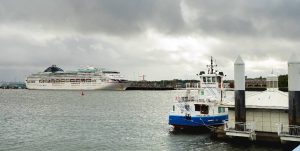
Image: Graeme J. Baty/Shutterstock.com
Just downstream from the Old Customs House at the Market Place is the South Shields ferry terminal, from where there are regular ferry services across the River Tyne to North Shields.
Airport
Newcastle International Airport is located approximately 18 miles (29 km) from South Shields, near Ponteland. It is also connected to the town via the Metro rail system. The expected journey time to/from South Shields to Newcastle Airport via car or taxi would be around 30 minutes and 50 minutes or so, via the Metro. There are numerous short-haul and long-haul flights to multiple destinations throughout Europe, Asia and the Americas.
Places to see in South Shields!
There’s a surprising number of things to see in and around South Shields, a couple of suggestions are:
Arbeia Roman Fort
Arbeia Roman Fort dates back to AD 160 and was the military base that guarded the River Tyne. The Fort has excavated remains and meticulously reconstructed buildings of the original design. There’s also finds discovered at the site on display that helps to give a unique insight into life in Roman Britain. Arbeia also holds regular events throughout the summer, from Roman gladiator training to hands-on family activities.
The Fort is open every day, April through to September, 10 am to 5 pm on weekdays, with restricted hours at weekends. Best of all, admission is free!
Tynemouth Priory and Castle
Just across the River Tyne from South Shields, Tynemouth Priory and Castle overlooks the North Sea, dominating the headland. With its 2000 years of history and spectacular views, it’s a great place to while away a few hours for those with an interest in history. The interactive ‘Life in the Stronghold’ exhibition tells the story of the site from its origins as an Anglo-Saxon settlement, and then through the Ages as an Anglican monastery, a royal castle, artillery fort and coastal defence.
Man with donkey
In Ocean Road in the town centre, stands a memorial statue ‘Man with donkey’, created by local sculptor Robert Olley. The sculpture is a tribute to locally born John Simpson Kirkpatrick. He was a member of the ANZAC forces who took part in the disastrous WWI Gallipoli campaign in 1915, eventually losing his life to Turkish sniper fire. However, in the days before his death, under constant fire on the frontline, he managed to rescue more than 300 wounded men during the conflict, with the assistance of a donkey. His heroic efforts are widely recognised in his adopted country of Australia.
Things to do in South Shields!
Just a few of the things to do in and around South Shields would be:
Watch South Shields F.C
If you like your Non-League football then a trip to the 1st Cloud Arena to see “The Mariners” play has to be on your agenda! They are a club with a lot of history (and reincarnations) and who can forget that memorable FA Vase victory at Wembley in 2017!
Did you miss it? Well, fear not as we have embedded the highlights for you. It really was a great game – if you are a South Shields Fan anyway.
At the time of writing (2021), they play in the Northern Premier League – Premier Division which is tier 7 on the FA Pyramid and given the ground holds 3500 you should be ok paying at the gate.
Learn to surf!
The North East of England is probably one of the least imagined places where you’d think about learning to surf, right? Well, think again, because the South Shields Surf School offers lessons for both adults and kids of any ability. The School’s instructors have world-class experience and are all qualified beach lifeguards. The School aim to have you on the surfboard within minutes and are focused on improving your surfing technique. If you’re already experienced, you can hire a wetsuit and board for a great day surfing at the local Sandhaven Beach.
Learn to ride!
Thought about learning to ride a horse but never got around to it? Well if you happen to find yourself in South Shields now’s your chance. With greatly experienced instructors, the North Lizard Riding School are able to cater for adults and children of all riding abilities. So, whether you are a novice rider or the next best thing to John Wayne, it’s an activity that singles, couples or families can equally enjoy.
Tyne River Cruises
During the summer months, you can take a river cruise on the bustling River Tyne. Experienced guides provide running commentary on the local landscape as you sail down the river, helping you to gain a unique perspective on the area. There’s a range of tours, which specialise in different experiences, including animal encounters and children’s entertainment. Cruises leave from South Shields ferry landing, next to The Customs House, on selected summer dates.
Where to stay?
A broad indication of prices for the most readily available types of accommodation in South Shields are:
Hotel: £80 – £120 (2 people sharing)
Lodge/B & B/Guesthouse: £40 – £80 (2 people sharing)
Apartment/Holiday home: £80 – £120 (usually sleeping 2 – 6 people)
The South Shields Quiz
Quiz Maker – powered by Riddle
So there it is our guide to South Shields together with a potted history and even a quiz to see if you were paying attention! Before you go why not try some of our other quizzes or have a look at some of our other location guides. better still why not join our growing community it’s free and could be very rewarding going forward.
